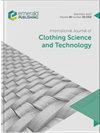包络物包埋蜡菊油及其在棉织物中的抗菌活性研究
IF 1
4区 工程技术
Q3 MATERIALS SCIENCE, TEXTILES
International Journal of Clothing Science and Technology
Pub Date : 2023-08-16
DOI:10.1108/ijcst-11-2022-0156
引用次数: 0
摘要
目的制备抗菌胶囊,并采用浸渍法将其转移到棉织物上。设计/方法学/方法为此,采用三种不同摩尔比的揉制方法,用ß-环糊精(ß-CD)包封蜡菊油。然后通过浸渍法将产品应用于100%纯棉织物。形态学鉴定表明,包合物表面光滑,呈球形。傅里叶变换红外光谱和差示扫描量热分析结果证实,蜡菊油在1:1、1:2和1:3的摩尔比下,ß-CD与活性剂形成包合物。通过分析,确定了含ß-CD:蜡菊油胶囊的最高络合率在9.72% ~ 1:2之间,确定了1:2的颗粒尺寸在2 ~ 25µm之间。经过5次洗涤,确定了织物上是否存在胶囊。对金黄色葡萄球菌和大肠杆菌进行了抑菌活性评价。抗菌分析结果表明,包合物对金黄色葡萄球菌和大肠杆菌的抑菌效果均达96%以上,织物在洗涤5次后仍具有抗菌效果。经5次洗涤后,油的主要成分有所减少,但气相色谱分析仍有明显的峰。这些结果表明,蜡菊油可以用于其抗菌性能,并且已经观察到,当以包合物的形式转移到织物中时,这种活性可以持续到5次洗涤。原创性/价值蜡菊油在化妆品中应用广泛,但在纺织品中的应用研究较少。因此,本研究对蜡菊油进行分子包封,利用其抗菌性能在纺织品中的潜在应用进行了研究。在纺织工业中使用天然来源的物质,如蜡菊油,可以提供一种环保和可持续的替代品。这项研究可以被认为是朝着纺织工业开发创新和天然抗菌产品迈出的一步。本文章由计算机程序翻译,如有差异,请以英文原文为准。
Encapsulation of helichrysum oil with inclusion complex and investigation of antibacterial activities in cotton fabrics
PurposeThe aim of this study was to prepare antibacterial capsules and transfer them to cotton fabrics using the impregnation method.Design/methodology/approachFor this purpose, helichrysum oil was encapsulated by ß-cyclodextrin (ß-CD) using the kneading method at three different molar ratios. The products were then applied to 100% cotton fabric through the impregnation method.FindingsMorphological assessment showed that the inclusion complex had smooth surfaces and spherical shapes. Fourier transform infrared spectroscopy and differential scanning calorimeter analysis results confirmed the formation of the inclusion complex between ß-CD and the active agent at mole ratios of 1:1, 1:2 and 1:3 for helichrysum oil. According to the analyses, it was determined that the highest complexing rate was between 9.72% and 1:2 in capsules containing ß-CD:helichrysum oil and the sizes of particles which is 1:2 are determined to be between 2 and 25 µm. The presence of capsules on the fabrics was determined after 5 washing cycles. Antibacterial activity was evaluated against Staphylococcus aureus and Escherichia coli bacteria. The antibacterial analysis results showed that the inclusion complex provided a reduction of over 96% against both S. aureus and E. coli bacteria, and the fabrics exhibited antibacterial effects even after 5 washing cycles. The major constituents of the oil were decreased after 5 washes, but significant peaks were remained according to the gas chromatography analyses. These results indicate that helichrysum oil can be used for its antibacterial properties, and it has been observed that this activity continues up to 5 washes when transferred to the fabric in the form of an inclusion complex.Originality/valueAlthough helichrysum oil is widely used in cosmetics, there is a lack of studies on its application in textiles. Therefore, this study investigated the potential use of helichrysum oil, which has a wide range of applications, in textiles for its antibacterial properties through molecular encapsulation. The use of naturally sourced substances such as helichrysum oil in the textile industry can offer an environmental and sustainable alternative. This study can be considered as a step toward the development of innovative and naturally sourced antibacterial products in the textile industry.
求助全文
通过发布文献求助,成功后即可免费获取论文全文。
去求助
来源期刊
CiteScore
2.40
自引率
8.30%
发文量
51
审稿时长
10 months
期刊介绍:
Addresses all aspects of the science and technology of clothing-objective measurement techniques, control of fibre and fabric, CAD systems, product testing, sewing, weaving and knitting, inspection systems, drape and finishing, etc. Academic and industrial research findings are published after a stringent review has taken place.

 求助内容:
求助内容: 应助结果提醒方式:
应助结果提醒方式:


